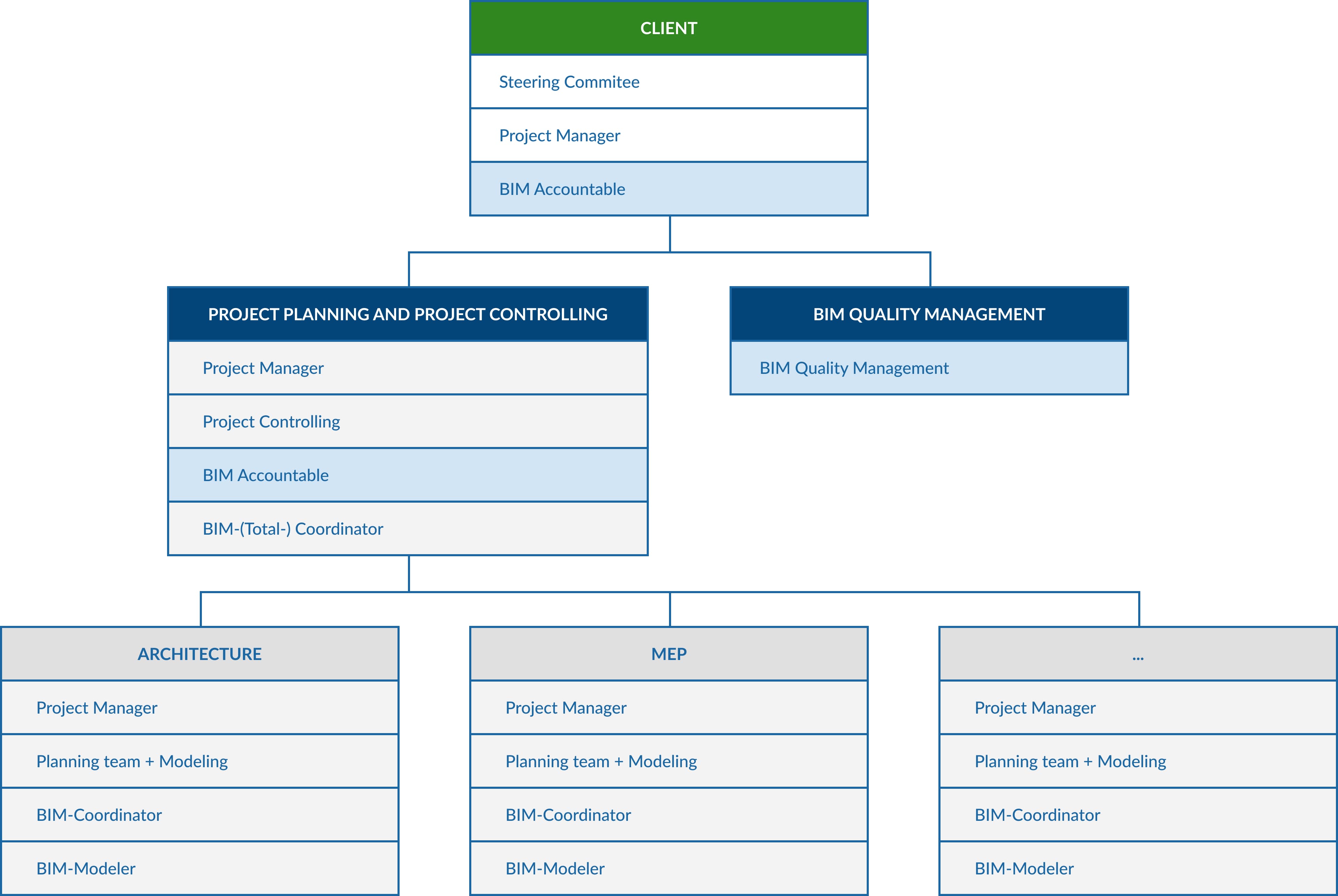The BIM roles and organizational structure
To be able to execute BIM projects, not only BIM-capable software and new methods are required, but also adjustments in the structural organization of the project, in particular with the introduction of new BIM roles. The organizational chart shows a simplified, exemplary project structure organization. The example shows the client as an organizational unit as well as one or more contractors, e.g. the overall planner with project control, and then the individual architectural/specialist planning areas. Each organizational unit is usually equipped with (partial) project management. Depending on the purpose of the organizational unit, this is supplemented by additional positions, e.g. steering committee at the client, project control at the overall planner, planning team at the specialist planners, etc. The gray-blue illustration now shows the roles that are added by BIM.

The following aspects become obvious:
- Almost every “classic” role is supplemented with a BIM role.
- There must also be a BIM Accountable on the client side.
- BIM managers must be given a similar importance as project managers.
- Coordination and quality management are particularly important.
Every project and BIM projects in particular need a clearly defined distribution of roles. In the following, we will briefly introduce the essential BIM roles. In future blog articles, we will go into detail about the respective roles.
BIM Accountable (sometimes also: Information Manager)
The benefits of BIM must become tangible for clients and builders as well as users. This can be done in different ways: decision support, more efficient planning, transparency/progress control, availability of planning data in operation. In any case, the client must define in advance what he or she expects from the application of the BIM method. Defining BIM goals, however, is not easy due to the high level of complexity, especially many dependencies and a wide variety of perspectives. It is even more difficult to record them precisely and to demand them or check that they have been achieved. It is therefore advisable to define a specific role, the BIM Accountable. Together with the Project Manager, he or she is responsible for formulating the BIM goals, drafting the project specific EIR (Employer’s Information Requirements) and communicating them to the contractors. He or she releases the implementation of the BIM objectives to be described by the contractors within the framework of a BEP (BIM Execution Planning). The BIM Accountable also creates the boundary conditions for collaboration in the project. In the course of the project, the BIM Accountable receives results and checks them according to the agreements. Parts of the areas of responsibility are occasionally outsourced to the contractors or third parties and are subject to the specific project design.
BIM Quality Manager
The field of responsibility of the BIM Accountable is very comprehensive and in particular the verification of compliance with agreed qualities is time-consuming. For this reason, it is advisable to involve a dedicated BIM Quality Manager. This is often done externally; in which case it is commissioned separately and reports directly to the client. The quality manager supports the BIM Accountable and also the contractor in formulating and comparing the EIR and BEP. The quality manager then ensures the implementation of the specifications made for the application of the BIM method. He or she is closely involved in project coordination and participates in the acceptance of individual service phases. This also includes the interface with contractors and the final review of the as-built model for handover to operations. For this purpose, the BIM Quality Manager usually makes use of specialized BIM quality management tools and automatic checking mechanisms, both in terms of geometry and, above all, information (attributes).
BIM Manager
The BIM Manager is responsible for implementing the BIM method in the project. As the person responsible for the BIM strategy in the project, he or she is responsible for developing the BEP and for combining the contributions of all contractors into a common BEP. Within the framework of this and beyond (e.g. in modeling guidelines), he or she defines and documents the BIM method to be used, including processes, model development levels, software to be used, data exchange formats, etc. The BIM Manager is also responsible for ensuring that the BIM strategy is implemented in accordance with these guidelines. The tasks also include setting up the shared software in accordance with these specifications, in particular the CDE (Common Data Environment). This also includes setting up workflows, authorizations per role, etc. During implementation, the BIM Manager ensures the application of the BIM method and updates the BIM maturity level. He is supervised by the BIM Accountable or BIM Quality Manager and works closely with the total BIM Coordinator.
BIM (Total-) Coordinator
From the contractor’s point of view, the BIM total coordinator is responsible for the delivery of the agreed content, in particular BIM models. In this function, he or she represents the connecting link between the BIM Manager and the BIM coordinators at the specialist planning level and represents them. The BIM total coordinator applies the agreed methods and tools at the operational level and ensures their use, particularly at the interfaces. The most important responsibility lies in the area of the overall model, which is made up of the submodels of the specialist planners. This includes, above all, the coordination across the trades, both in terms of geometry (such as a collision/connection check) and in terms of information (such as consistent attribute names or redundancy-free information). Finally, he or she also issues the release and ensures the availability of the content at the client. This also includes the technical realization and application of the CDE (Common Data Environment), in accordance with the agreed planning cycles.
BIM Coordinator at specialist planning level
The BIM Coordinator at the specialist planning level has a similar task to the BIM total coordinator, except that his or her scope is limited to the respective specialist area. From a BIM point of view, this BIM Coordinator at specialist planning level represents the respective planning team and is responsible for the punctual delivery of the agreed content in accordance with requirements and quality, in particular the associated BIM specialist models. Within the scope of his or her specialist area, this coordinator is thus the main contact person for the BIM Total Coordinator. The special challenge for the BIM coordinator results from the reconciliation of the requirements arising from the project and the internal regulations of the company or department.
BIM Modeler
The BIM modeler creates the partial models and is thus responsible for both their geometry and information content. This includes, in particular, the factual and technical correctness. He or she must ensure that all relevant model-related data is available and consistent in the partial model. This also includes reconciliation with the specialized models of other departments. Before passing on models to other departments, the coordinator approves them. The coordinator is also responsible for providing documents that result from the model, e.g. plans, parts lists, etc.



